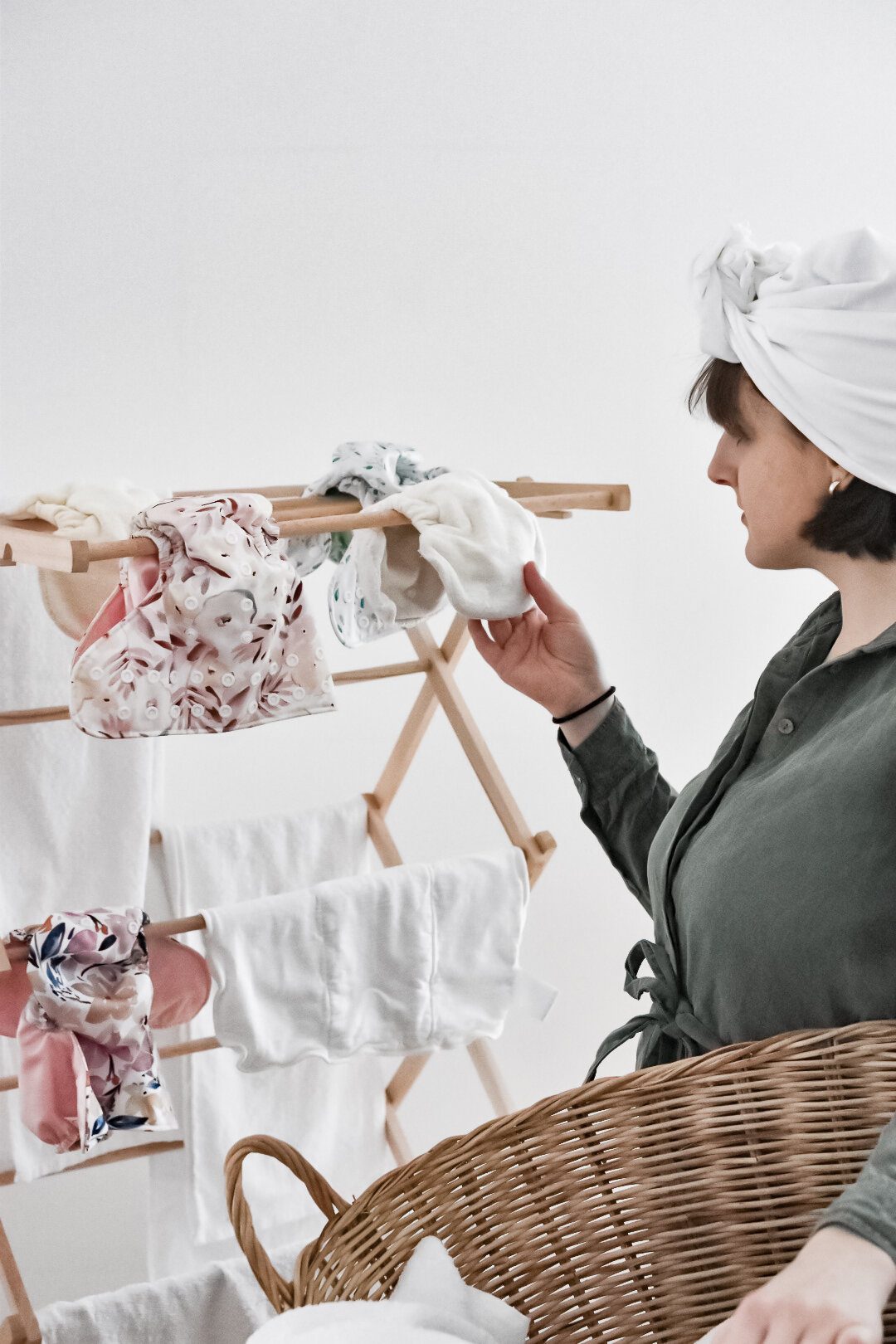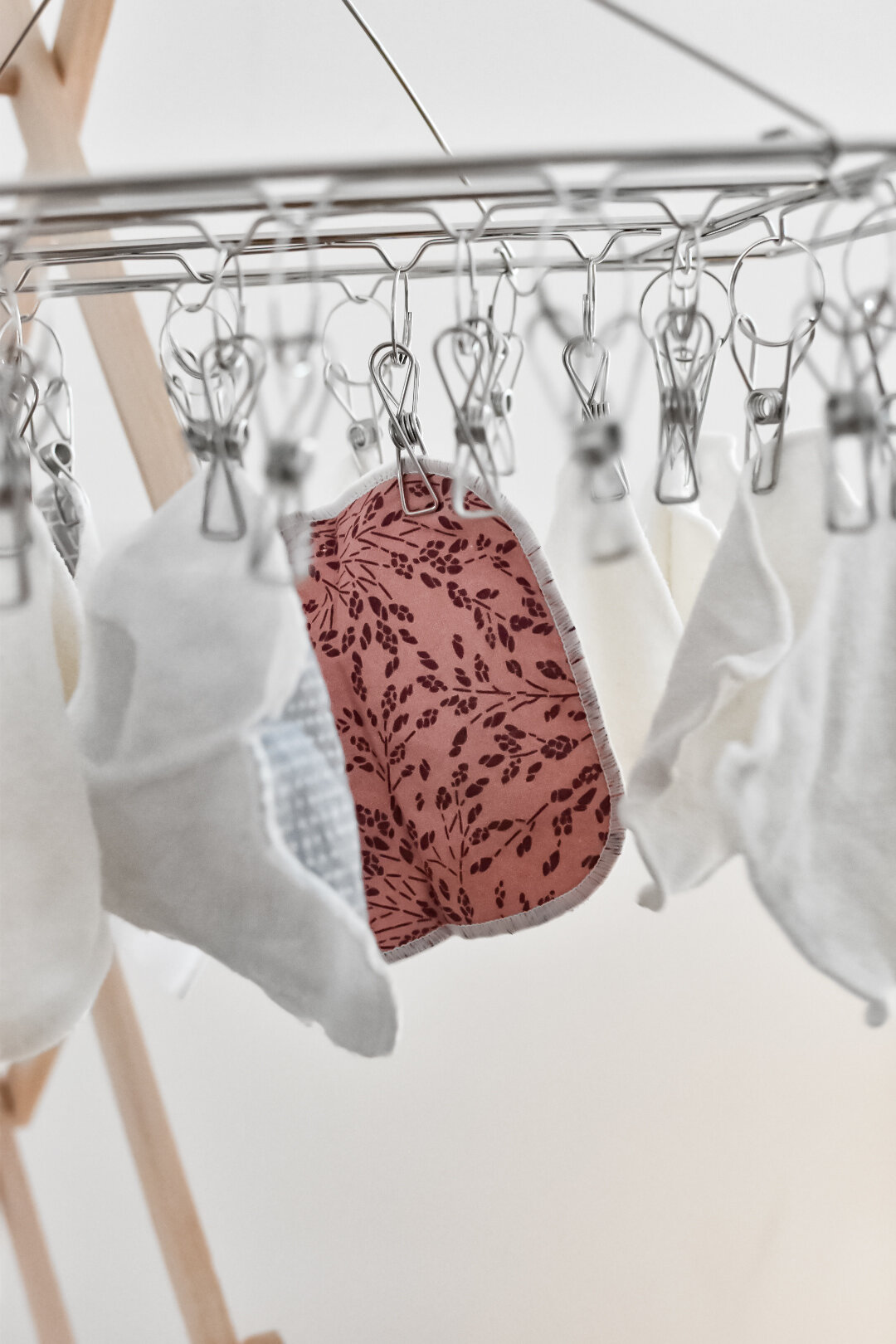How to Wash Cloth Nappies : Everything You Need to Know
There’s one aspect of using reusable nappies that has the potential to completely turn people off, and that’s the washing. Not only is there a perception that it’s dirty, but it can seem complicated and time-consuming. But it really doesn’t have to be!
If you’re just getting started and want the basics, all you need to read is part 1 of this post! This will give you everything you need to get going.
If you have a specific question that isn’t answered in part 1, check out part 2 to see if it’s answered there.
If you’re having trouble with your wash routine or your nappies are smelly or secondhand, read on to part 3.
And if you’re still having trouble after that, get in touch with me!
Part 1 : The Basics
How should I store my cloth nappies before washing? Do they need to be soaked?
One of the biggest myths about cloth nappies is that they need to be soaked before washing. This isn’t the case! Nappies that are just wet can be popped straight into a nappy bucket or large wet bag to await washing. For soiled nappies, if your baby is pre-weaning, these too can go straight into the wash bag. However, if your baby is eating any amount of solids, then you need to rinse the poo (yes, I’m going to call it poo!) off the nappy before it goes into the wash. Using nappy liners can help with this - fleece liners don’t ‘cling’ to the poo, so it can be easily shaken off into the toilet, or if necessary rinsed with a showerhead into the toilet. Some people prefer to use disposable liners which can be put in the bin.
Whatever you are storing your nappies in, make sure there is a flow of air. So if you’re using a bag, leave it unzipped, or if using a bucket, keep the lid off. It’s counterintuitive, but this will prevent your dirty nappies from smelling.
How do I wash my reusable nappies?
You will need to put your nappies through two washes - pre-wash and main wash.
Pre-wash
Empty your nappy bucket or bag into the machine and put it on a 30-60 minute wash cycle at 40°C, with up to half a dose of detergent as specified on the packet. Start with no detergent, and increase if you find you’re not getting a great clean. Most people won’t need any detergent. Don’t confuse this with the pre-wash setting on your machine - it needs to be an actual cycle.
Main wash: Before you put this wash on, make sure that your machine is ⅔ to ¾ full by adding small pieces of clothing, hand towels and tea towels. Just make sure that the things you add are white or light coloured, to avoid colour run. Then put your machine on its longest cycle (at least 2 hours long) at either 40°C or 60°C, with a full dose of detergent as specified on the packet.
How often should I wash them?
You can wash as often as you like, but it’s wise not to go more than 3 days without a wash if you want your nappies to last a long time. Most people opt for washing every other day.
What detergent should I use?
If you’re in the UK, you can use any bio or non-bio detergent as long as it doesn’t contain fabric softener. Both washing powder and liquid are fine, but some people prefer powder since it doesn’t come in a plastic bottle. If you use a non-bio detergent, you are more likely to need to do your main wash at 60°C, as it isn’t quite as effective at cleaning organic matter as bio detergent. Note that if you’re not in the UK, some bio powders contain ingredients that can be harmful to bamboo nappies, so it’s worth checking with your nappy manufacturer if the detergent is safe for nappies.
It’s very important that you use the right amount of detergent as specified on the packet. It will probably look like way too much but remember that nappies are very dirty and need the very best clean!
There is no need to use special laundry boosters. A good detergent will do the job.
Can I use fabric softener?
No, fabric softener coats the fibres on cloth nappies and can make them less effective.
Part 2 : Other Frequently Asked Questions
How do I wash second-hand cloth nappies?
It’s a good idea to run a strip wash on any second-hand nappies - see the instructions at the bottom of this post on how to run a strip wash.
How do I wash brand new nappies?
When you first get your new nappies, you’ll need to wash them before use just like any other baby clothes. You should use the main wash instructions that I give above. Nappies that are made of natural fibres such as hemp and cotton will need several washes, sometimes up to 10, before they reach full absorbency. Many people choose to use them after a couple of washes and just change more regularly.
Can I wash reusable nappies with clothes?
Yes - you can add clothes to your main wash, just make sure that they’re white or light coloured to avoid colour run.
Which is better for storing nappies - a bucket or a bag?
This is totally personal preference! I prefer a bag because I can put it straight into the washing machine with my nappies rather than having to wipe a bucket down manually.
Can I tumble dry reusable nappies?
The short answer: it depends! Check the label on your nappies and see what it says. Generally speaking, nappies with no PUL (waterproof) elements are fine to be tumble dried, but this isn’t always the case. Also, as with anything, using the tumble dryer excessively will shorten the life of your nappies, and it isn’t great for the environment, so even if your nappies are dryer safe it’s wise to line dry them as much as possible.
Do I need to do anything special to my washing machine?
You should be cleaning your washing machine once a month regardless of whether you use reusable nappies, but many people don’t. Cleaning your machine becomes even more important when you’re washing nappies in it. Mark your calendar to run a machine clean on the first of every month so you don’t forget.
Take the detergent drawer out and clean it in hot soapy water. Make sure it’s completely dry before you put it back. Then run the machine empty on a long, hot wash with (optionally) a cup or two of distilled vinegar. Finally, check the filter and clean out any nasties. Leaving the machine door slightly ajar between washes helps to prevent mould and mildew build-up in the drum and seal.
Part 3 : Troubleshooting
My nappies are coming out of the wash smelly
It’s likely that you aren’t using enough detergent. Make sure you’re using up to a half dose in the pre-wash and a full dose in the main wash. If you’re still having issues, it could be that you have a build-up of ammonia from long term poor washing. You can usually tell that it’s ammonia build-up by the smell - it’s sharp and sweet and can even give off fumes that literally make your eyes water! It tends to be more obvious with night nappies or when little ones are teething. If that’s the problem, you will need to do a strip wash by following the instructions I’ve put at the end of this post.
In future, make sure you’re using the right amount of detergent so that the problem doesn’t return. It can also help to rinse night nappies straight after use to prevent ammonia from starting to develop while they’re waiting to be washed. You can rinse them using your shower head - just make sure you’re doing it in a bucket or over the toilet!
My nappies don’t look clean
First off, if your nappies are stained but they smell fine and look clean otherwise, and you’ve got a good wash routine, you don’t necessarily need to change anything. A bit of staining is not a problem. If you want to get rid of the staining, hanging your nappies out in the sun will help lighten the stains. Adding a squeeze of lemon juice before you hang them out will also help things along! If you don’t have outside space, you can still put your nappies by a sunny window. For really stubborn stains, some people like to add half a scoop of a laundry booster to their pre-wash, but check the warranty conditions on your nappies first, as some warranties will be voided if you use certain products.
If your nappies are actually coming out dirty, there are two possible problems. Firstly, you may not be using enough detergent, so make sure you’re using the amount specified on the packet. You need to take into account that nappies are heavily soiled, and the water hardness in your area. You can check the hardness of your water here. The right amount might seem like too much! For me, living in a hard water area, I need around 200ml of a standard supermarket powder, which completely fills the slot in my washing machine drawer.
If you’re using the right amount of detergent and still having problems, it’s possible that your machine is over-full or under-full for your main wash, which means your nappies aren’t getting properly agitated. Try adjusting the amount of nappies and clothing in your main wash - you’re aiming for the drum to be around ⅔ to ¾ full.
How to do a nappy strip wash
If you have a good wash routine and your nappies are looking and smelling clean, there should be no reason to do a strip wash. However, if you have washed your nappies poorly for a long time, or if they are second-hand and haven’t been looked after well, you may need to do a strip wash. Here’s how to do it:
Run a rinse cycle or a 40°C short wash with no detergent.
Put your machine on its longest cycle (several hours long) at either 40°C or 60°C, with a full dose of detergent as specified on the packet.
Repeat the longest cycle but this time with no detergent.
Run a rinse cycle and check that there are no suds in the machine. If there are suds, run another rinse cycle. Repeat until there are no suds.
Hanging your nappies out in the rain for a day or two is helpful too!
Some people advocate for bleaching nappies after stripping them. This isn’t necessary and could invalidate the warranty on your nappies.
Getting more help
I hope that was helpful! If you’ve read this whole post and you’re overwhelmed, do get in touch. Nappy washing seems harder than it is - once you get going it is usually very easy!
This page contains affiliate links, which earn me a little bit of commission if you make a purchase, at no additional cost to you. Thank you!






